Stuttgarter Beiträge zur Naturkunde - Staatliche Museen für ...
Stuttgarter Beiträge zur Naturkunde - Staatliche Museen für ...
Stuttgarter Beiträge zur Naturkunde - Staatliche Museen für ...
Create successful ePaper yourself
Turn your PDF publications into a flip-book with our unique Google optimized e-Paper software.
schmalfuss et al., bibliography of terrestrial isopods 41<br />
GRUNER, H. (1953): Der Rollmechanismus bei kugelnden Landisopoden und Diplopoden. –<br />
Mitt. zool. Mus. Berlin 29: 148–179; Berlin.<br />
– (1954): Über das Coxalglied der Pereiopoden der Isopoden. – Zool. Anz. 152: 312–317;<br />
Leipzig.<br />
– (1955): Die Gattung Benthana. – Zool. Jahrb. Syst. 83: 441–452; Jena.<br />
– (1966 a): Die Tierwelt Deutschlands. 53. Teil. Krebstiere oder Crustacea. V. Isopoda, 2.<br />
Lieferung, pp. 151–380; Jena.<br />
– (1966 b): Über Protracheoniscus asiaticus und die verwandten Arten. – Mitt. zool. Mus.<br />
Berlin 42: 307–319; Berlin.<br />
GRUNER, H. & TABACARU, I. (1963): Revision der Familie Mesoniscidae. – Crustaceana 6:<br />
15–34; Leyden.<br />
GRÜNWALD, M. (1988 a): Adaptation und Dekompositionsleistung von Landasseln an Standorten<br />
der Großen Brennessel (Urtica dioica). – Hochschulsammlung Naturwissenschaft,<br />
Biologie, Band 20, 273 + 71 pp.; Freiburg/Breisgau.<br />
– (1988 b): Die Landasseln Bayerns – Verbreitung, Gefährdung und Schutz. – Schriftenr.<br />
bayer. Landesamt Umweltsch. 83: 97–99; Munich.<br />
– (1990 a): Beitrag <strong>zur</strong> Kenntnis der Landasseln der Donauhänge zwischen Passau und<br />
Jochenstein (Niederbayern). – Bayer. Wald 24: 19–23; Zwiesel.<br />
– (1990 b): Vorschlag <strong>für</strong> eine Rote Liste der in Bayern gefährdeten Landasseln. – Schriftenr.<br />
bayer. Landesamt Umweltsch. 99: 183–186; Munich.<br />
GUEORGUIEV, V. & BERON, P. (1962): Essai sur la faune cavernicole de Bulgarie. – Annls<br />
Spéléol. 17: 285–356, 360–441; Paris.<br />
GUERIN, F. (1832): Les Crustacées. Isopodes. – In: BRULLÉ, A., Expedition scientifique de<br />
Morée. Section des Sciences physiques. 3, 1ère partie. Zoologie, 2e Section, pp. 46–50.<br />
GUI, H. & TANG, B. (1996): A new species of the genus Trachelipus [certainly not this genus!].<br />
– Acta zootax. sinica 21: 283–286; Beijing.<br />
GUI, H., TANG, B. & WU, T. (1994): Research on the terrestrial isopods of the lower reaches<br />
of Changjiang (Yangtse River)(I). -J. Nanjing normal Univ. (nat. Sci,) 17: 64–70;<br />
Nanjing.<br />
GUIEYSSE-PELLISSIER, A. (1906): Étude des corps blancs ou poumons chez l’Helleria brevicornis.<br />
– Bull. Soc. philomath. Paris (9) 8: 203–209.<br />
GULIČKA, J. (1957): Qualitativ-quantitative Analyse der Bodenfauna von Černy les. – Acta<br />
Fac. Rer. nat. Univ. Com. (Zool.) 2: 119–139; Bratislava.<br />
– (1960): Der Einfluss der Wasserstandsschwankung auf die Bodenmakrofauna des St.<br />
Georger Moores (Diplopoda, Chilopoda, Isopoda) [Slovakian with German summary].<br />
– Acta Fac. Rer. nat. Univ. Com. (Zool.) 4: 437–486; Bratislava.<br />
GUNN, D. (1937): The humidity reactions of the woodlouse Porcellio scaber. – J. exp. Biol. 14:<br />
178–186; Cambridge.<br />
GUNNARSSON, T. (1987): Selective feeding on a maple leaf by Oniscus asellus. – Pedobiol. 30:<br />
161–165; Jena.<br />
GUNNARSSON, T. & TUNLID, A. (1986): Recycling of fecal pellets in isopods: micro-organisms<br />
and nitrogen compounds as potential food for Oniscus asellus. – Soil Biol. Biochem. 18:<br />
595–600; Oxford.<br />
GUPTA, M. (1962): Contact chemoreception in Oniscus asellus and Porcellio scaber. – J. zool.<br />
Soc. India 14: 145–149; Calcutta.<br />
HADLEY, N. & HENDRICKS, G. (1985): Cuticular microstructures and their relationship to<br />
structural color and transpiration in the terrestrial isopod Porcellionides pruinosus. –<br />
Can. J. Zool. 63: 645–656; Ottawa.<br />
HADLEY, H. & QUINLAN, M. (1984): Cuticular transpiration in the isopod Porcellio laevis:<br />
chemical and morphological factors involved in its control. – Symp. zool. Soc. Lond.<br />
53: 97–107; London.<br />
HADLEY, H. & WARBURG, M (1986): Water loss in three species of xeric-adapted isopods: correlations<br />
with cuticular lipids. – Comp. Biochem. Physiol. 85A: 669–672; New York,<br />
NY.<br />
HAFERKORN, J. (1998): Rote Liste der Asseln des Landes Sachsen-Anhalt. – Ber. Landesamtes<br />
Umweltsch. Sachsen-Anhalt 30: 28–29; Halle.<br />
HAFFNER, K. V. (1937): Über die ursprüngliche und abgeleitete Stellung der Beine bei den Isopoden.<br />
– Z. wiss. Zool. 149: 513–537; Leipzig.<br />
HALDANE, J. (1962): Evidence of heterosis in woodlice. – J. Genet. 58: 39–40; Hyderabad.



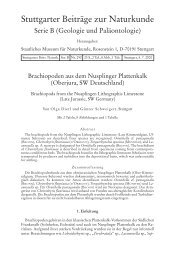

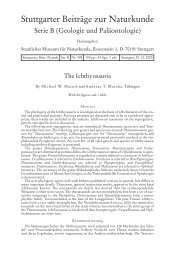


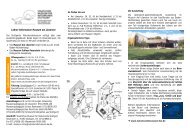


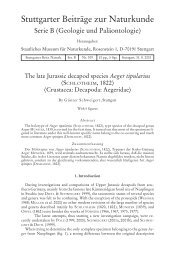
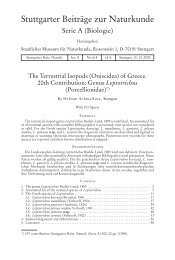
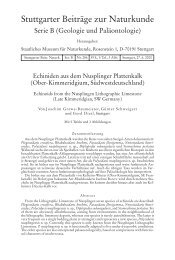
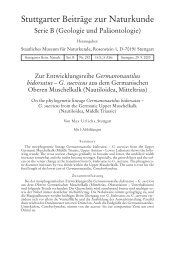
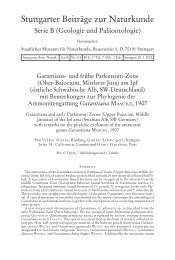
![[PDF] Stuttgarter Beiträge zur Naturkunde](https://img.yumpu.com/5473603/1/175x260/pdf-stuttgarter-beitrage-zur-naturkunde.jpg?quality=85)